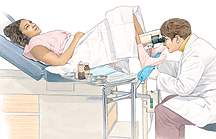Colposcopy
Colposcopy is a procedure that gives your healthcare provider a magnified view of the cervix. It is done using a lighted microscope called a colposcope. In most cases, a sample of cervical cells is taken during a biopsy. The sample can then be studied in a lab. If any problems are found, you and your healthcare provider will discuss treatment options. It usually takes less than 30 minutes, and you can often go back to your normal routine right away.
Reasons for the Procedure
Colposcopy is usually done as a follow-up exam to help find the cause of an abnormal Pap test. Abnormal Pap tests are often due to an HPV (human papilloma virus) infection. HPV is a large family of viruses. HPV can cause genital warts. It can also cause changes in cervical cells. Colposcopy is also used to assess other problems. These include pain or bleeding during sexual intercourse, or a lesion on the vulva or vagina.
 What Are the Risks?
What Are the Risks?
Problems after colposcopy are very rare, but can include:
Getting Ready for the Procedure
Colposcopy is normally done in your healthcare provider's office. It will be scheduled for a time when you're not having your menstrual period. You may be asked to sign a form giving your consent to have the procedure. A day or two before the procedure, your healthcare provider may also ask you to:
-
Avoid sexual intercourse.
-
Stop using tampons.
-
Avoid using creams or other vaginal medications.
-
Avoid douching.
-
Take over-the-counter pain medications an hour or two before the procedure.
During Colposcopy
-
You will be asked to lie on an exam table with your knees bent, just as you do for a Pap test.
-
An instrument called a speculum is inserted into the vagina to hold it open.
-
A vinegar solution is applied to the cervix to make the cells easier to see. You may feel pressure or a slight burning for a few moments. In some cases, the cervix may be numbed first with an anesthetic.
-
The cervix is viewed through the colposcope, which is placed outside the vagina.
-
If your healthcare provider sees abnormal areas on the cervix, a biopsy will be done. The tissue sample is sent to a lab for study.
-
You may feel slight pinching or cramping during the biopsy. Medication may be applied to the biopsy site to stop bleeding.
After the Procedure
-
If you feel lightheaded or dizzy, you can rest on the table until you're ready to get dressed.
-
If a biopsy was done, you may have mild cramping or light bleeding for a few days. You may also have discharge from the medication used to stop bleeding at the biopsy site.
-
Use pads, not tampons, for at least the first 24 hours.
-
If you have any discomfort, over-the-counter pain medication can provide relief.
-
Ask your healthcare provider when you can resume sexual intercourse.
Follow-Up
If a biopsy was done, your healthcare provider will get the lab report in a week or two. You and your healthcare provider can then discuss the results. In some cases, you may be scheduled for further tests or treatment. Be sure to keep follow-up appointments with your healthcare provider.
Call your healthcare provider if you have:
-
Heavy vaginal bleeding (more than a pad an hour for 2 hours).
-
Severe or increasing pelvic pain.
-
A fever over 101°F.
-
Foul-smelling or unusual vaginal discharge.
Publication Source: National Library of Medicine
Online Source: National Library of Medicine
Date Last Reviewed: 2007-01-15T00:00:00-07:00
Date Last Modified: 2004-10-01T00:00:00-06:00







